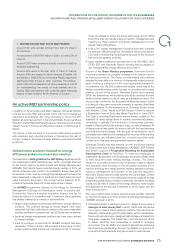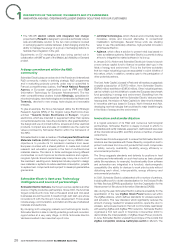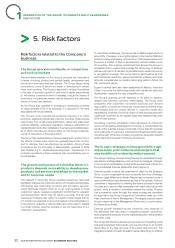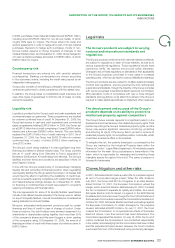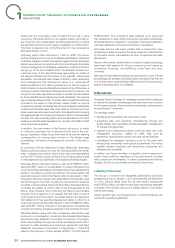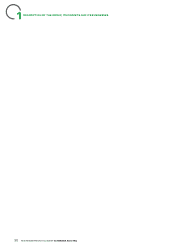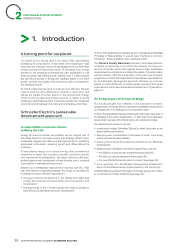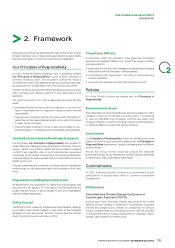APC 2009 Annual Report Download - page 36
Download and view the complete annual report
Please find page 36 of the 2009 APC annual report below. You can navigate through the pages in the report by either clicking on the pages listed below, or by using the keyword search tool below to find specific information within the annual report.
2009 REGISTRATION DOCUMENT SCHNEIDER ELECTRIC34
DESCRIPTION OFTHEGROUP, ITSMARKETS ANDITSBUSINESSES
1RISK FACTORS
fi nding that the Commission was not liable for the loss in value
incurred by Schneider Electric on its Legrand shares. According to
the ruling, the only compensation due Schneider Electric concerns
the legal fees from the second merger investigation in October2002.
The Court is expected rule on the fi nal amount to be recovered by
Schneider Electric in 2010.
Following public offers launched in 1993 by SPEP (the Group
holding company at the time) for its Belgian subsidiaries Cofi bel and
Cofi mines, Belgium initiated proceedings against former Schneider
Electric executives in connection with the former Empain-Schneider
Group’s management of its Belgian subsidiaries, notably the Tramico
sub-group. At the end of March2006, the Brussels criminal court
ruled that some of the defendants were responsible for certain of
the alleged offenses and that certain of the plaintiffs’ claims were
admissible. The plaintiffs claim losses of EUR 5.3million stemming
from management that reduced the value of or under-valued
assets presented in the offering prospectus, as well as losses of
EUR 4.9million concerning transactions carried out by PB Finance, a
company in which Cofi bel and Cofi mines had a minority interest. In its
ruling, the court also appointed an expert to assess the loss suffered
by those plaintiffs whose claims were ruled admissible. The expert’s
report was submitted in 2008. The defendants contest the amounts
provided by the expert in their entirety, based notably on reports
produced by Deloitte. Schneider Electric and its Belgian subsidiaries
Cofi bel and Cofi mines were held civilly liable for the actions of their
senior executives who were found liable. Schneider Electric is paying
the legal expenses not covered by insurance of the former executives
involved. The case is pending before both the Brussels Court of First
Instance and the Brussels Appeals Court, as parts of the March2006
ruling have been appealed.
In addition, the new owners of the Tramico sub-group, to which
a Cofimines subsidiary had advanced funds during the sub-
group’s liquidation, refuse to pay back said funds and are claiming
compensation for having been involved in the Belgian legal
proceedings. Arbitration proceedings are currently under way in
Geneva.
In connection with the divestment of Spie Batignolles, Schneider
Electric booked provisions to cover the risks associated with certain
major contracts and projects. Most of the risks were extinguished
during 1997. Provisions were booked for the remaining risks, based
on management’s best estimate of the expected fi nancial impact.
Schneider Electric has been ordered to pay Chint RMB330million
(around EUR 31million) in compensation for patent infringement by
one of its Chinese subsidiaries. Schneider Electric has appealed this
decision. The dispute concerns production of a circuit breaker that
uses technology for which Chint fi led a utility model patent in 1997.
The patent has since expired. Schneider Electric had already used
this technology for more than 15years on products sold in numerous
countries, including China, before the Chint fi ling. Schneider Electric
contested the validity of Chint’s utility model and appealed to the
Beijing High People’s Court following the Beijing Intermediate
People’s Court’s rejection of its request that the utility model be
ruled null and void. In the interim, the parties came to an agreement
that settled all of their pending disputes and claims in return for a
lump-sum payment by Schneider Electric to Chint of RMB157million
(around EUR 17million). Pursuant to this agreement, the parties are
currently terminating all legal proceedings in the countries involved.
Schneider Electric, along with other companies in the industry, was
involved in an investigation concerning Gas Insulated Switchgear
launched by New Zealand’s Commerce Commission. The Group,
which was implicated through two former subsidiaries sold in 2001,
decided to settle amicably and signed an agreement with New
Zealand’s Commerce Commission on September 1, 2008 that
called for the payment of a fi ne capped at NZD 1 ,100,000 (around
EUR 500,000). The competent New Zealand court approved
this transaction in early 2009 and the fi ne was paid immediately.
Schneider Electric is required to cooperate in the local investigation
with New Zealand’s Commerce Commission if requested.
Schneider Electric has been notified that a class-action type
proceeding in Israel concerning the same equipment manufactured
by the same former subsidiaries and other competitors has been
abandoned.
Various other claims, administrative notices and legal proceedings
have been filed against the Group concerning such issues as
contractual demands, counterfeiting, bodily harm and work
contracts.
Although it is impossible to forecast the results and/or costs of these
proceedings with certainty, Schneider Electric considers that they will
not, by their nature, have signifi cant effects on the Group’s business,
assets, fi nancial position or profi tability.
Insurance
Schneider Electric’s strategy for managing insurable risks is designed
to defend the interests of employees and customers and to protect
the Company’s assets, the environment, employees, customers and
its shareholders’ investment.
This strategy entails:
•identifying and quantifying the main areas of risk;
•preventing risks and protecting manufacturing through site
audits, hazard and vulnerability studies and safety management
for people and equipment;
•organising and deploying business continuity plans and crisis
management resources, notably for health risks such as
pandemics, technical and political risks and natural disasters;
•maintaining the necessary insurance cover for the main risks
facing Group companies under global programmes . The Group
carefully screens insurance and reinsurance companies and
evaluates their solvability.
In addition, the Group has taken out specifi c cover in response to
certain local conditions, regulations or the requirements of certain
risks, projects and businesses. To extend guarantees and reduce
budgets, the Group coordinates purchasing of local cover.
Liability insurance
The Group is covered by an integrated global liability insurance
programme set up on January 1, 2007 and extended until December
31, 2010. Insured values under this “all risks except” programme
total EUR 230million per claim and per year, representing adequate
coverage of the Group’s exposure to liability claims in connection
with its businesses.
Certain specifi c risks, such as aeronautic or environmental risk, are
covered by specifi c programmes .



